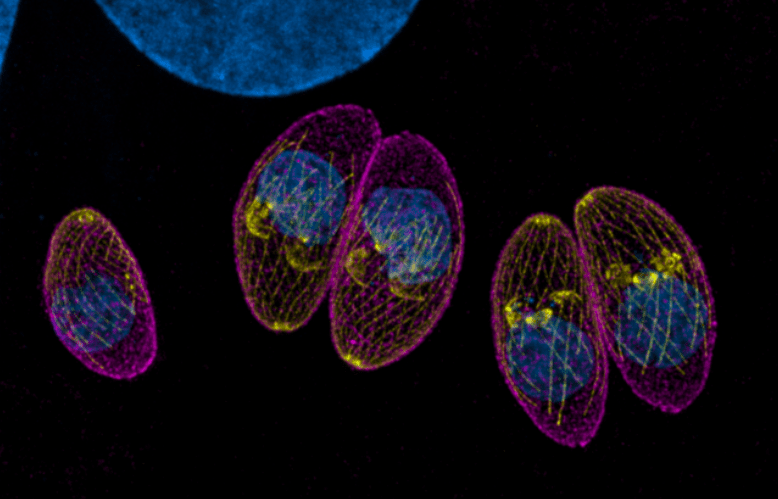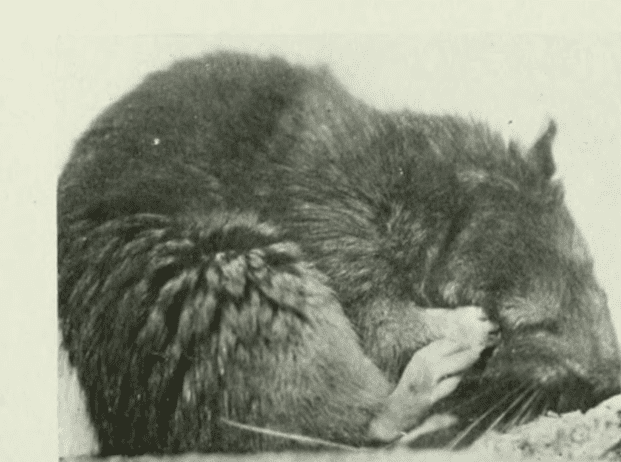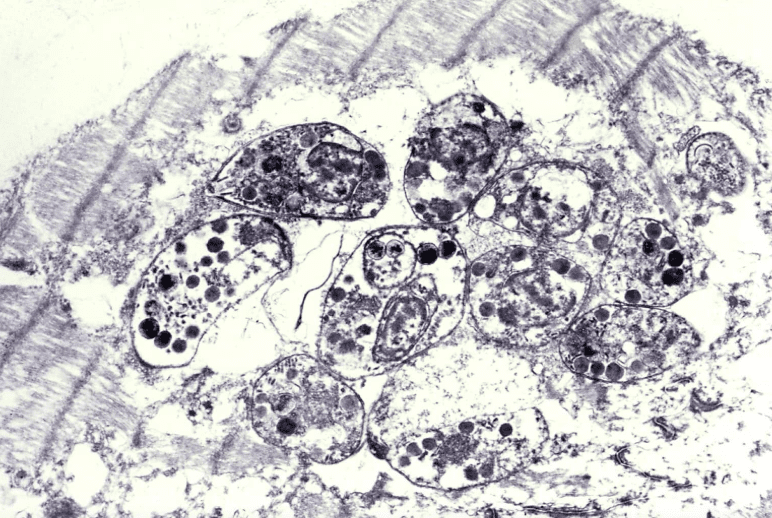What ubiquitous little parasite purposely changes the behavior of its host, through some method researchers can’t even agree on?

Morne Arin via Wikimedia Commons, CC-BY-4.0; image is cropped)
Science fiction (and horror) features a lot of mind-controlling parasites. Someone gets infected, is completely taken over, and makes it their mission to spread the disease as far and wide as they can. The parasite consumes their brain, and they become just another vector for the organism’s spread.
While that’s obviously a little far-fetched in real life, there are animals that use humans and other animals purely as vectors to stay alive, and there are even organisms that can alter the behavior of others to make their own survival as easy as possible.
A parasite is an organism that lives either on or inside another organism (a host) and benefits at the host’s expense; it steals food and nutrients from its host and often harms the host in other ways, too. This relationship between a host and a parasite is a type of symbiosis called parasitism.
There are several kinds of hosts in a parasitic relationship, but the most important are definitive and intermediate hosts: definitive hosts are the parasite’s ultimate hosts; the parasite can reproduce sexually in these hosts, allowing it to complete its life cycle. Intermediate hosts are just hosts where the parasite ends up on the way to the definitive host; they can still reproduce in intermediate hosts, but only asexually—by dividing inside host cells to create new copies of themselves, rather than mixing DNA from two parents as we do..
Incidental hosts are hosts the parasite ends up in by accident, and they don’t really help the organism reach its target destination, the definitive host. Reservoir hosts are those that harbor the parasite but aren’t affected by it; they just end up carrying it elsewhere.
Many hosts, whether they’re definitive, intermediate, or something else, are animals like mammals, fish, birds, or insects—but parasites can also infect much smaller organisms, even other microbes.

Public Domain
Parasites can be all kinds of organisms, but tend to be very small: single-celled organisms, insects, and worms (like a tapeworm) are common examples. Toxoplasma gondii is an extremely tiny single-celled parasite- around 1/20th the width of a strand of your hair!
T. gondii is found in several hosts, but its only definitive host is the cat. Its most common intermediate hosts are rodents. Cats are its only definitive hosts because their intestines provide a unique environment where T. gondii can reproduce sexually— due in part to cats’ low levels of the enzyme delta-6-desaturase, which allows linoleic acid to build up and trigger that process.
This parasite can also infect most other warm-blooded animals, such as deer, dogs, and even people. In fact, it’s pretty common for humans to have this parasite —around 30% of us worldwide have been infected at least once. In the United States, that rate is much lower, but it can be as high as 80% in other countries around the world.Now in humans, T. gondii keeps a low profile. Chances are, you wouldn’t even know it was there. In rare cases, it can develop into an actual infection called toxoplasmosis; with symptoms similar to the flu. Neurological changes are possible, but also rare. A severe infection can cause dizziness, clumsiness, slower thought processing, and lower stress levels (while that doesn’t necessarily sound like a bad thing, risky behavior can lead to an increased risk of car accidents.

Humans are an incidental host, so all of these changes are accidental. The host T. gondii actually wants to manipulate is the intermediate host: rodents. In mice and rats, a Toxoplasma gondii infection changes their behavior. Infected rodents tend to take more risks if there’s a threat of a predator, like cats, and become more aggressive. Typically, rodents are repelled by the smell of cat urine because they don’t want to be in places cats have been before. It’s a survival instinct, and the infection gets right in the middle of that. Their lowered guard inevitably leads to more infected rodents being eaten, giving the parasite easy access to its definitive host, the cat and its abundant delta-6-desaturase enzyme. There, the parasite can finish its life cycle and reproduce, to spread and infect other animals again.
This is an example of what is known as parasite-increased trophic transmission, in which a parasite increases its own survival by making its intermediate host (a rodent, in this case) more likely to be consumed by a predator (a cat). The behavioral changes T. gondii causes in rodents make them more likely to act aggressively and fearlessly, leading them to be caught by cats when they don’t run away. In this way, T. gondii drives ecological interactions between different species.
The obvious question is how. It’s complicated stuff, no doubt. There are a couple of different theories as to how the parasite causes these oddly specific behavioral changes, but none is without their own flaws and uncertainties.
The first major theory is tropism. Parasitic infections like these often form cysts; those small nodes, clusters, or pockets of tissue in the body that aren’t supposed to be there, often filled with something unusual. T. gondii cysts contain hundreds of individual T. gondii cells, all dormant and ready to be reactivated later. These cysts aren’t spread evenly around the body, though– they’re concentrated in areas like the brain, eyes, and other immune-privileged locations. The cysts form where they can better hide from the body’s immune system. Tropism says that the physical location of these cysts plays a part in how they affect the host. In humans, they’re vaguely denser in certain areas of the brain, like the hypothalamus and amygdala. These parts of the brain deal with your mood and fear response, which is just the sort of thing that goes wrong in infected rodents. The theory is that, because there are more cysts in those locations, they’re able to interfere with how those neurons function. They might do this through inflammation and swelling, by physically destroying neurons, or by releasing certain chemicals.
As foreshadowed, it’s not a perfect explanation. Even when cysts are cleared or inactive, some behavioral effects can persist, suggesting that changes in the brain may outlast the infection itself.

The second major theory is that the parasite disrupts human dopamine production. Dopamine is a neurotransmitter that deals with reward and motivation. Toxoplasma gondii has two genes that allow it to increase dopamine production in its neighboring neurons. In humans and infected organisms, dopamine levels are much higher in areas with cysts. Too much dopamine can cause a decrease in stress responses and can cause animals to take more risks, with the motivation to explore new smells, like cat urine.
The final major theory is that the parasite also changes testosterone and vasopressin levels in its host. Exposure to more of these chemicals increases aggressiveness and decreases caution, making the rodent more likely to be eaten by cats. This theory also holds because male rats are more likely to exhibit strong behavioral changes in response to an infection than females. Several studies have tested this, and testosterone levels have been shown to increase in humans and in rats, but strangely, not in mice.
Several studies have examined each of these theories and sought to test and disprove them; many disagree with one another. No one has fully agreed on which possibility is correct, and perhaps there is a more nuanced truth that combines of all of them. No matter what’s going on under the hood, T. gondii is able to infect intermediate hosts and alter their behavior to get closer to its definitive host, advancing its own life cycle.
Toxoplasma gondii isn’t the only parasite that does this, either: the zombie-ant fungus causes ants to drop their regular behavior and start to climb as high as they can before dying; the fungus will then release its spores, which tend to travel further and infect more insects because they have more room to travel if they’re in the air instead of on the ground. The rabies virus is also a common example; the classic “foaming at the mouth” appearance is actually a result of overproduction of saliva that contains the virus itself. The virus makes the host more aggressive, increasing the likelihood that it will bite others and spread the infection. Also, the common rumors that rabies makes you scared of water aren’t entirely false. While it doesn’t actually create a fear of water, the infection causes painful throat spasms that make swallowing difficult—so infected animals avoid drinking, which keeps the virus-rich saliva from being washed away.

The world is full of parasites that alter behavior in oddly precise ways, all in an effort to increase their own survival and reproduction. These manipulations aren’t random—they’ve evolved over time through complex, codependent relationships that change predator-prey dynamics, influence brain chemistry, and even change how energy moves through ecosystems. Parasites like T. gondii show just how interconnected species are to each other; no species exists in a vacuum, and even something as small as a single-celled organism can affect completely different species; any tiny piece of something has the potential to change everything else.

Anya Reddy is a high school student at Blue Valley North. She loves biology and biochemistry, as well as entomology, ecology, and environmental science in general. Some of Anya’s non-science passions include archery and all kinds of 2D and 3D art. She enjoys learning about all kinds of organisms and how they connect and interact with others in their environment; she hopes to use writing to help share fascinating details about them, helping others like the weird and interesting organisms she loves.
Dig Deeper
- CDC Toxoplasmosis
- Mechanisms of Host Behavioral Change in Toxoplasma gondii Rodent Association
- Intestinal delta-6-desaturase activity determines host range for Toxoplasma sexual reproduction



